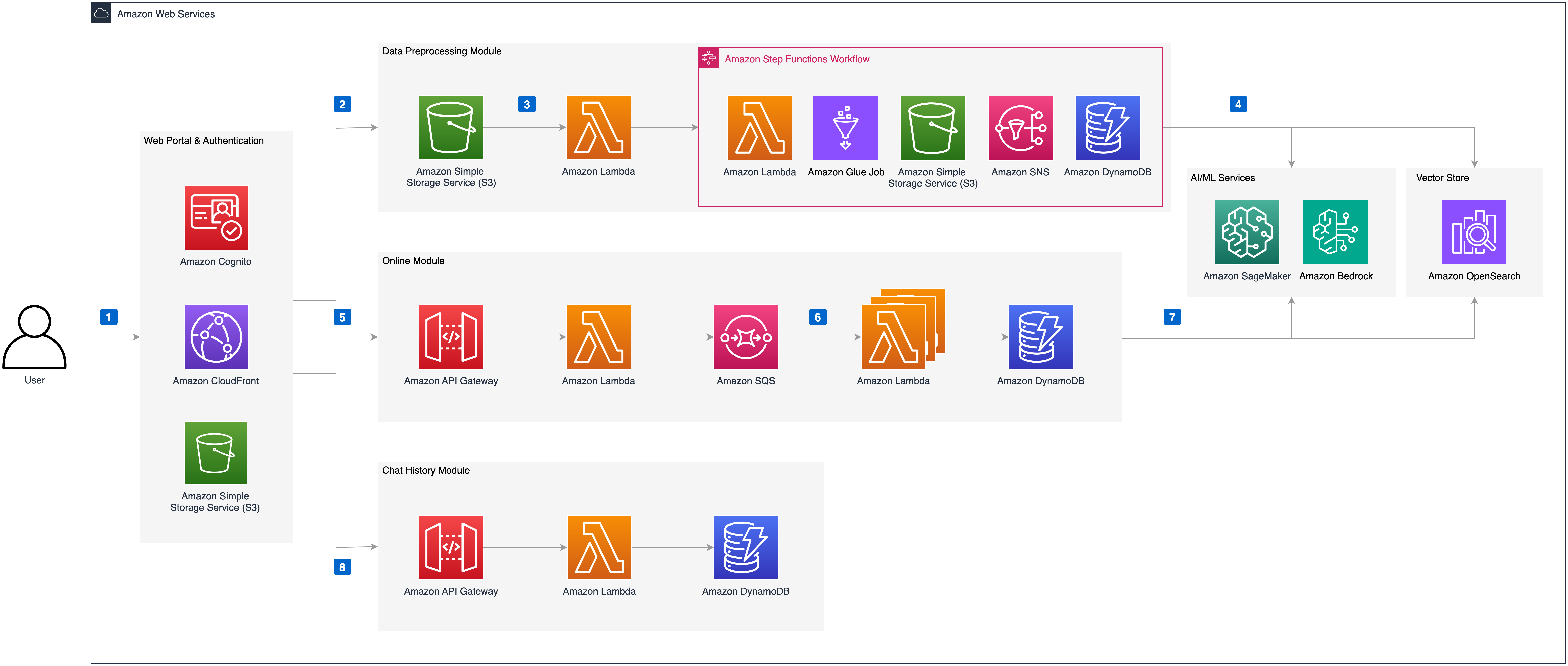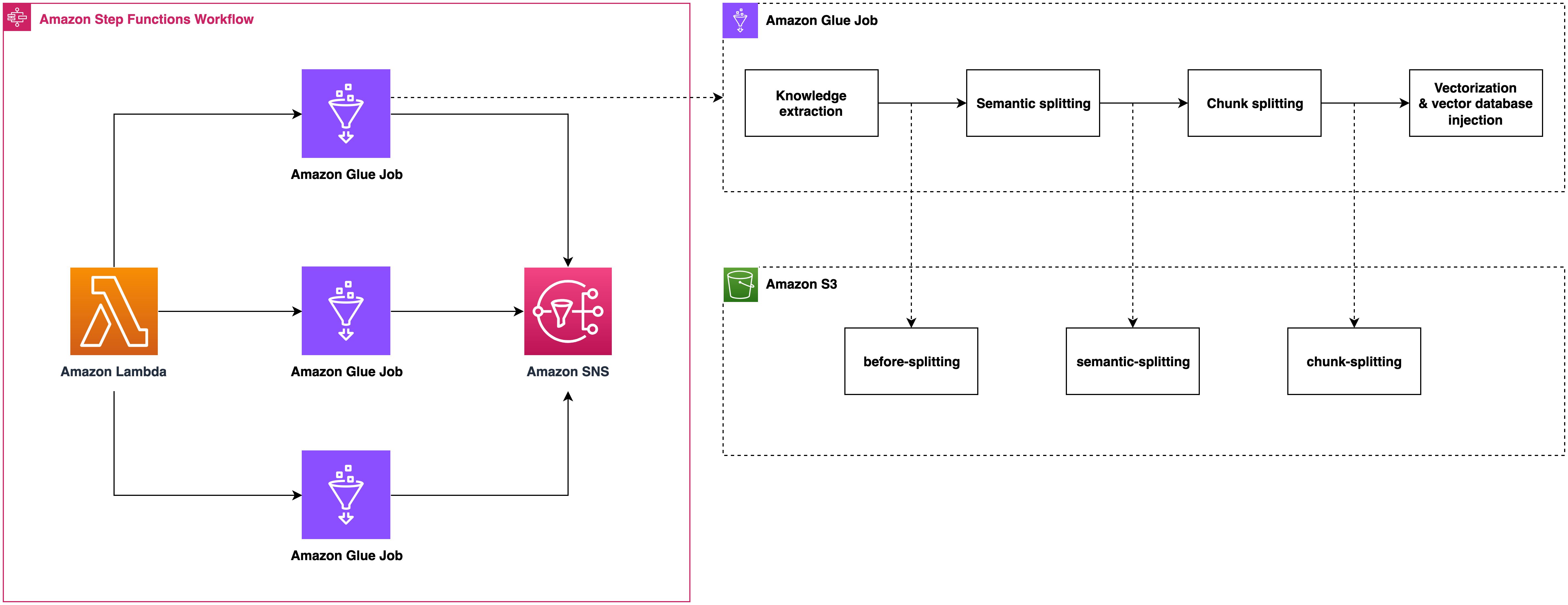Chatbot Portal with Agent offers a streamlined workflow for developing scalable, production-grade agent-based applications, such as conversational chatbots. Key features include:
-
Enterprise Knowledge Base Creation: Users can upload private documents in various formats (PDF, DOCX, HTML, CSV, TXT, MD, JSON, JSONL, PNG, JPG, JPEG, WEBP) to construct a personalized knowledge base.
-
Flexible Mode Options: Choose from multiple modes (Agent, Chat, RAG) to suit diverse requirements. For instance, the Agent model can interpret user intent, select appropriate tools, and act on iterative results.
-
Configurable Chat-Based UI: Our React/Next.js chat interface is user-friendly, making it easy to configure, explore, and customize to meet your specific needs.
-
Comprehensive RESTful API: Our full-featured API facilitates easy integration with existing applications, enhancing functionality and user experience.
Chatbot Portal with Agent is designed to empower developers to rapidly deploy intelligent, context-aware applications with minimal overhead and maximum efficiency.
Deploying this solution using the default parameters will build the following environment in Amazon Web Services:
The execution process is as follows:
- The solution's front-end website is hosted in an Amazon S3 bucket and distributed via Amazon CloudFront. Authentication is provided by an Amazon Cognito user pool.
- When users upload documents to the knowledge base through the solution's website, the documents are first uploaded to the Amazon S3 bucket.
- An Amazon Lambda function is then triggered, which in turn triggers an Amazon Step Functions workflow to process the file. Within Amazon Step Functions, the document is parsed and segmented using an Amazon Glue Job, with intermediate states stored in Amazon DynamoDB and Amazon S3.
- The Amazon Glue Job vectorizes the segmented text blocks using an Embedding model deployed in an Amazon SageMaker Endpoint and injects them into the vector database Amazon OpenSearch. If the document is in image format (e.g., png, webp) or a pdf with images, the Amazon Glue Job uses Amazon BedRock to interpret the images and convert them to text. Finally, Amazon SNS sends the execution result to the user via email.
- When users send chat messages through the solution's website, the online module's Amazon API Gateway is triggered. Front-end and back-end communication is achieved via WebSocket API. An Amazon Lambda function integrated with Amazon API Gateway sends the request message to Amazon SQS to prevent message timeout.
- Messages in Amazon SQS are consumed by the online module's Amazon Lambda, which executes Agent/RAG/Chat logic based on the request parameters and records the chat messages in Amazon DynamoDB. The Amazon Lambda function uses intent recognition to determine the necessary tools and perform the corresponding operations.
- If the RAG model is selected, the Amazon Lambda function vectorizes the query message using the Embedding model deployed in the Amazon SageMaker Endpoint, retrieves matching knowledge from Amazon OpenSearch, reorders the results, and sends the knowledge to the large language model, which then returns the answer to the front end.
- During the chat, messages between the user and AI are stored in Amazon DynamoDB. The solution's website retrieves a specific chat record through Amazon API Gateway and Amazon Lambda, allowing the user to continue the conversation based on the content of that chat record.
Its data preprocessing module includes format recognition, content extraction, metadata conversion, and semantic segmentation, seamlessly in the background.
When a large number of content injection requests are received, it can automatically scale out by running multiple Amazon Glue jobs concurrently, ensuring these requests are processed in time.
Chunk metadata is defined as below shown:
| Name | Description |
|---|---|
| file_path | S3 path to store the file |
| file_type | File type, eg. pdf, html |
| content_type | paragraph: paragraph content |
| current_heading | The heading which the chunk belongs to |
| chunk_id | Unique chunk id |
| heading_hierarchy | Heading hierarchy which is used to locate the chunk in the whole file content |
| title | The heading of current section |
| level | Heading level, eg. H1 is #, H2 is ## in markdown |
| parent | The chunk id of parent section, eg. H2's parent is its H1, H3's parent is its H2 |
| previous | The chunk id of previous paragraph at the same Level |
| child | The chunk ids of sub sections |
| next | The chunk id of next paragraph at the same Level |
| size | The number of the chunks when the paragraph is splitted by a fixed chunk size |
Here is an example
{
"file_path": "s3://example/intelli-agent-user-guide.pdf",
"file_type": "pdf",
"content_type": "paragragh",
"current_heading": "# Intelli-Agent User Guide WebApp",
"chunk_id": "$1-4659f607-1",
"heading_hierarchy": {
"title": "Intelli-Agent User Guide",
"level": 1,
"parent": null,
"previous": null,
"child": [
"$2-038759db",
"$4-68d6e6ca",
"$6-e9cdcf68"
],
"next": null,
"size": 2
}
}
The following graph is generated by online logic which is built based on langgraph. The first node is query_preprocess_lambda which handles the chat history. Then the user can choose from three modes: chat, rag and agent. The chat mode lets you interact directly with different LLMs, such as Anthropic Claude 3. The rag mode will retrieve the relevant contents relating to the current query and let LLM answer it. The agent mode is the most complex mode which gives you the possibility to handle complex business scenarios. Given the most relevant intention from intention_detection_lambda and chat history from query_preprocess_lambda, agent_lambda will decide which tools to use and whether the information is enough to answer the query. The parse_tool_calling node will parse the output of agent_lambda:
- agent_lambda chooses the wrong tool from the perspective of tool format, it will be forced to think again through invalid_tool_calling edge.
- agent_lambda chooses the valid tool, the tool will be executed through tool_exectue_lambda. Then, agent_lambda will decide whether the running results are enough to answer the query.
- There are some cases that agent_lambda decides to give the final response. For cases needing RAG, the rag_retrieve_lambda and rag_llm_lambda will be called. For cases that agent_lambda needs more information, the give_rhetorical_question node will be executed. For cases where a constant reply needs to be given, the transfer_reply and comfort_reply will be executed. The give_final_response means the current results of tool calling is enough to answer the query.
flowchart TD
subgraph ReAct["ReAct"]
direction TB
tools_choose_and_results_generation["tools_choose_and_results_generation"]
results_evaluation{{"results_evaluation"}}
tools_execution["tools_execution"]
end
_start_["_start_"] --> query_preprocess["query_preprocess"]
query_preprocess == chat mode ==> llm_direct_results_generation["llm_direct_results_generation"]
query_preprocess == rag mode ==> all_knowledge_retrieve["all_knowledge_retrieve"]
query_preprocess == agent mode ==> intention_detection["intention_detection"]
all_knowledge_retrieve --> llm_direct_results_generation & llm_rag_results_generation["llm_rag_results_generation"]
intention_detection -- similar query found --> matched_query_return["matched_query_return"]
intention_detection -- intention detected --> tools_choose_and_results_generation
tools_choose_and_results_generation --> results_evaluation
results_evaluation -. invalid tool calling .-> tools_choose_and_results_generation
results_evaluation -. valid tool calling .-> tools_execution
results_evaluation -. no need tool calling .-> final_results_preparation["final_results_preparation"]
tools_execution --> tools_choose_and_results_generation
llm_direct_results_generation --> _end_["_end_"]
llm_rag_results_generation --> _end_
matched_query_return --> final_results_preparation
final_results_preparation --> _end_
tools_choose_and_results_generation:::process
results_evaluation:::process
tools_execution:::process
query_preprocess:::process
llm_direct_results_generation:::process
all_knowledge_retrieve:::process
intention_detection:::process
llm_rag_results_generation:::process
matched_query_return:::process
final_results_preparation:::process
style query_preprocess fill:#FF6D00,color:#FFFFFF
style ReAct fill:#FFCDD2,color:#D50000
Follow these steps to get started:
Execute following commands to install dependencies such as Python, Git, npm, docker and create a service linked role for Amazon OpenSearch service. You can skip this step if they are already installed.
wget https://raw.githubusercontent.com/aws-samples/Intelli-Agent/dev/source/script/setup_env.sh
sh setup_env.shExecuting the following command to clone the GitHub repo:
git clone <this repo>Navigate to the script directory and run the build.sh script. This script requires an S3 bucket name as an argument, which will be used to upload the model. Please make sure the bucket name is located in the same region as the CDK deployment. It also requires ETL image name, ETL image tag, and AWS region as arguments. The ETL image will be pushed to your ECR repo with the image name you specified.
cd source/script
sh build.sh -b <S3 bucket name> -i <ETL model name> -t <ETL tag name> -r <AWS region>For example:
sh build.sh -b intelli-agent-model-bucket -i etl-image -t latest -r us-east-1Please make sure docker is installed and the CDK command is executed in the same region of the model files which were uploaded in the previous step.
Start the deployment by executing the following command:
cd source/infrastructure
npx cdk deploy --parameters S3ModelAssets=<S3 Bucket Name> --parameters SubEmail=<email address> --parameters EtlImageName=<ETL model name> --parameters ETLTag=<ETL tag name>To deploy the offline process only, you can configure context parameters to skip the online process.
npx cdk deploy --parameters S3ModelAssets=<S3 bucket name> --parameters SubEmail=<email address> --parameters EtlImageName=<ETL model name> --parameters ETLTag=<ETL tag name> --context DeploymentMode="OFFLINE_EXTRACT"| Parameter | Description |
|---|---|
| S3ModelAssets | Your bucket name to store models |
| SubEmail | Your email address to receive notifications |
| OpenSearchIndex | OpenSearch index name to store the knowledge, if the index does not exist, the solution will create one |
| EtlImageName | ETL image name, eg. etl-model, it is set when you executing source/model/etl/code/model.sh script |
| EtlTag | ETL tag, eg. latest, v1.0, v2.0, the default value is latest, it is set when you executing source/model/etl/code/model.sh script |
| Context | Description |
|---|---|
| DeploymentMode | The mode for deployment. There are three modes: OFFLINE_EXTRACT, OFFLINE_OPENSEARCH, and ALL. Default deployment mode is ALL. |
After CDK deployment, you can use a HTTP client such as Postman/cURL to invoke the API by following below API schema.
- LLM API Schema: send question to LLM and get a response.
- ETL API Schema: upload knowledge to the vector database.
- AOS API Schema: search data in the vector database.
For detailed test information, please refer to the Test Doc
See CONTRIBUTING for more information.
This project is licensed under the Apache-2.0 License.



